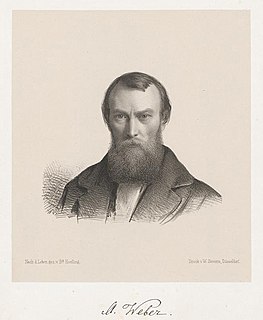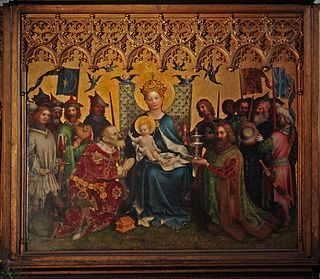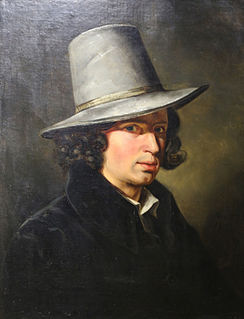
Johann Anton Alban Ramboux (5 October 1790, Trier - 2 October 1866, Cologne) was a German painter and lithographer. [1]

Johann Anton Alban Ramboux (5 October 1790, Trier - 2 October 1866, Cologne) was a German painter and lithographer. [1]
His father came from Savoy and his mother was from a famous family of goldsmiths. Christoph Hawich, his drawing teacher at the Bürgerschule (a type of commercial preparatory school) in Trier noted his artistic talent. As a result, in 1803 he received a recommendation to study with Jean-Henri Gilson (1741-1809), a former Benedictine monk who taught art in Florenville. [1]

After four years there, he received a further recommendation to study with Jacques-Louis David in Paris, where Ramboux remained until 1812. In 1815, he was admitted to the Academy of Fine Arts, Munich, becoming a pupil of Konrad Eberhard.
In 1816 he moved to Rome, where he lived until 1822. While there, he made the acquaintance of many fellow painters who were involved in the Nazarene movement. He returned to Trier for ten years, creating hundreds of watercolors of the city and the Moselle River, which he began reproducing as lithographs in 1825. This came to an end in 1827 when the lithography firm, owned by his former teacher, Hawich, went out of business. In 1832, he began another ten-year stay in Italy, producing landscapes and folk-scenes as well as copies of Renaissance frescoes and mosaics. [2]
In 1843, a curator was needed for the Wallraf Collection (now the Wallraf-Richartz Museum) in Cologne and Ramboux was recommended for the position by Johann Gottfried Schadow. He was appointed and took office in 1844. [1] Ten years later, he was able to make a long-desired pilgrimage to Jerusalem, producing hundreds of watercolors and lithographs along the way. [2] In 1858, he was made the first Honorary Citizen of Trier.
A street is named after him in the Longerich district of Cologne. Since 1961, the City of Trier has awarded the Ramboux Prize to promote the development of young artists.


Carl Joseph Begas, or Karl Begas, was a German painter who played an important role in the transition from Romanticism to Realism. He was the first in a multi-generational "dynasty" of artists.

Eduard Julius Friedrich Bendemann was a German-Jewish painter.

Karl Friedrich Lessing was a German historical and landscape painter, grandnephew of Gotthold Ephraim Lessing and one of the main exponents of the Düsseldorf school of painting.

Johann Peter Krafft was a German-born Austrian painter who specialized in portraits, historical works and genre scenes.

Anton Victor, Viceroy of Lombardy–Venetia was an Archduke of Austria and a Grand Master of the Teutonic Knights. He was also briefly the last Archbishop and Elector of Cologne and Prince-Bishop of Münster before those territories were secularised in 1803.

Johann Baptist Wilhelm August Weber was a German painter; associated with the Düsseldorfer Malerschule.

Johann Friedrich Bause was a German copper engraver; primarily of portraits.

Alexander Friedrich Wilhelm Duncker was a German publisher and bookseller.

Carl Georg Enslen was an Austrian-born German painter.

The term Cologne School of Painting was first applied in the 19th century to describe old German paintings generally. It subsequently came to refer more specifically to painters who had their workshops in medieval Cologne and the lower-Rhine region from about 1300 to 1550.

Johann Baptist Pflug was a German genre painter.

Wilhelm Lambert Krahe was a German history painter and art collector.

Ferdinand Franz Wallraf was a German botanist, mathematician, theologian, art collector and Roman Catholic priest. His collection formed the founding nucleus of the Wallraf–Richartz Museum.

Otto Schwerdgeburth was a German painter and engraver who mainly painted historical subjects.

Carl Peter Burnitz was a German landscape painter who began as a lawyer.

Theodor Zacharias Friedrich Alt was a German painter.

Friedrich Heinrich Ludwig Krevel, known as Louis Krevel was a German portrait painter of the Biedermeier period.

Simon Meister was a German painter.

Caspar Johann Nepomuk Scheuren was a German painter and illustrator.

Christian Eduard Boettcher, or Böttcher, was a German painter whose work comprised portraiture and genre painting.
| Wikimedia Commons has media related to Johann Anton Ramboux . |